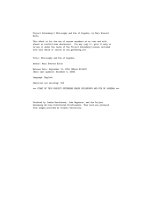Project Gutenberg''''s The Kirk on Rutgers Farm, by Frederick Brückbauer pdf
Bạn đang xem bản rút gọn của tài liệu. Xem và tải ngay bản đầy đủ của tài liệu tại đây (2.07 MB, 242 trang )
Project Gutenberg's The Kirk on Rutgers
Farm, by Frederick Brückbauer
This eBook is for the use of anyone
anywhere at no cost and with
almost no restrictions whatsoever. You may
copy it, give it away or
re-use it under the terms of the Project
Gutenberg License included
with this eBook or online at
www.gutenberg.org
Title: The Kirk on Rutgers Farm
Author: Frederick Brückbauer
Illustrator: Pauline Stone
Release Date: May 2, 2008 [EBook #25293]
Language: English
*** START OF THIS PROJECT GUTENBERG EBOOK
THE KIRK ON RUTGERS FARM ***
Produced by David Garcia and The Online
Distributed
Proofreading Team at The Kirk on
Rutgers FarmTHE
KIRK
on
Rutgers Farm
By
Frederick Brückbauer
Illustrated by
Pauline Stone
NEW YORK
Fleming H Revell Company
1919
To the
Men and Women
who gave
that the old church
might remain at
Market and Henry Streets
Contents
Introduction
Illustrations
Chapter I
Chapter II
Chapter III
Chapter IV
Chapter V
Chapter VI
Chapter VII
Jesus,
Savior,
Pilot Me
The Old
Church
The Old
Flag
Rally
Song
The
Shadow
of the
Wall
Ministers
Men
Workers at
Market
Street
Church
Women
Workers at
Market
Street
Church
Died in
Service
Church
Chapter
VIII
Students
at Market
Street
Church,
Ordained
Later
Officers
Old Church
Buildings
East Side
Streets
Bibliography
Transcriber's Note: The original of this work did not include a table
of contents.
The one given above has been inserted for the reader's
convenience.
INTRODUCTION
It is evident that the preparation of this
volume has been a labor of love.
Of the sanctuary which, for one hundred
years, has stood on the corner of Market
and Henry Streets, the author, like many
others who have put their lives into it,
might well say:
"Thy saints take pleasure in her stones,
Her very dust to them is dear."
The story of "The Kirk on Rutgers
Farm" is one of pathetic interest. In its
first half-century it sheltered a
worshipping congregation of staid
Knickerbocker type, which, tho blest with
a ministry of extraordinary ability and
spiritual power, succumbed to its
unfriendly environment and perished.
In its second half-century it became the
home of a flock of God, poor in this
world's goods, but rich in faith, to whom
the environment even when changing from
bad to worse, was a challenge to faith and
valiant service. Those of us who in our
unwisdom said a generation ago that it
ought to die judged after the outward
appearance. Those who protested that it
must not die, took counsel with the spirit
that animated them, saw the invisible and
against hope believed in hope.
Not the least impressive pages of this
book are the pages which record the
names of ministers and other toilers for
Christ, who in this field of heroic
achievement have lived to serve or have
died in service.
The author has very skilfully concealed
his personal connection with the history of
which he might justly say: "Magna pars
fui." But for his wise and winsome
leadership the chronicle would have
closed a quarter of a century ago.
By putting in form and preserving the
memories which cluster about the Church
of the Sea and Land, he is performing a
real service to the Christian community
and earning the gratitude of fellow-
laborers to whom it has been a shrine of
their heart's devotion.
George Alexander.
ILLUSTRATIONS
The Kirk on Rutgers Farm Frontispiece
Page
Henry Rutgers 12
The Rutgers Mansion 15
Rutgers Tablet 17
Nathan Hale Statue 19
First Presidential Mansion 20
Tablet in Church Vestibule 22
Philip Milledoler 23
North Dutch Church 24
Isaac Ferris 28
Organ 29
Old Lecture Room Pulpit 30
Theodore L. Cuyler at
Market Street
34
Theodore L. Cuyler later 35
Pew 41
Bell 46
Sailors' Home 50
52 Market Street 51
Hanson K. Corning 52
Edward Hopper 56
Communion Service 58
Christian A. Borella 61
Andrew Beattie 68
Old Sunday School Room 69
Alexander W. Sproull 71
Col. Robert G. Shaw 72
Kindergarten 73
Old Church Flag 78
John Hopkins Denison 81
Tower Study 82
52 Henry Street 83
Fresh Air Children 84
New Church Flag 87
John Denham 91
Old 61 Henry Street 94
New 61 Henry Street 95
Staten Island House when
bought
96
Staten Island House
renovated
97
Kitchen for Cooking Classes 99
Pulpit 104
Back of Pulpit 107
If there be one thing certain about New
York it is that nothing remains unchanged.
Not only do public works like the bridges
change the face of things, but private
activity effaces great structures to build up
still greater ones. This march of progress
is as relentless as a modern army,
levelling all before it.
In other lands churches have been
spared tho other buildings went down, but
even these in New York have
disappeared, whole districts being
deliberately deserted because churches
were no longer able to maintain
themselves there financially. This is
especially true of the great down-town
section of Manhattan, the Old New York,
in which only two churches remain that
have stood unchanged for a century.
Trinity church let old St. John's go, and
sixty churches have disappeared in forty
years on the lower East Side alone. We
lose much when old landmarks go, when
we can not make history more vivid for
our children by pointing out where the
great men of another day worshipt, men of
a day when other public assemblies were
rare, and the church was the center that
radiated influence. The old building is of
value because of the living beings
associated with it that were the life of the
community.
New York has hardly appreciated what
its great families have meant for it in the
past. The members of the Rutgers family,
for instance, always had a noble share in
the day and generation in which they
lived. Their ancestor came over in the
early days from Holland, spent some time
about Albany, and then came to New
York, branching out till Rutgers
bouweries and Rutgers breweries were
found in more than one place.
A Rutgers was on the jury in the great
Zenger trial that establisht the freedom of
the colonial press,—"the germ of
American freedom." The Rutgers were
Sons of Liberty and the Rutgers farm near
Golden Hill was one of their meeting
places. A Rutgers was a member of the
New York Provincial Congress and also
of the Stamp Act Congress. Alexander
Hamilton was engaged in a famous case
when a Rutgers defended herself against a
Tory who had taken possession of her
property during the Revolution.
It was a Rutgers who drained the
marshes west of the old Collect Pond and
so laid the foundations for the Lispenard
fortunes: a Lispenard married a fair
daughter of his neighbor Rutgers. That
stream still runs into the Broadway
Subway at Canal Street apparently
uncontrollable.
One Rutgers fell in the Battle of Long
Island, and while the old father died in
Albany, the British revenged themselves
on the younger brother by making a
Henry Rutgers
hospital of his fine house in New York.
The owner kept on fighting for freedom
during the whole Revolutionary War,
distinguishing himself at White Plains.
This was
Henry
Rutgers, in
whom
culminated
many of the
finest
characteristics
of a noble
ancestry. His
breadth of
view in an age
not quite so broad, is well shown in his
attitude towards churches and schools.
When he decided to open up his farm in
the Seventh Ward for building purposes he
gave land at Oliver and Henry Streets, at
Market and Henry Streets and at Rutgers
and Henry Streets for churches, and there
was more for the asking, tho only the
Baptists, the Dutch Reformed and the
Presbyterians took advantage of the offer.
The Rutgers Street site became the
birthplace of the Rutgers Presbyterian
church, beginning May 13, 1798, in a
frame building 36×64. In 1841 the present
stone church was built, and in 1862, as
did others, this organization moved
uptown. A Mr. Briggs, who was holding
the property for a Protestant denomination,
finally tired of waiting and sold the
building to the Roman Catholic church, in
whose hands it remains.









